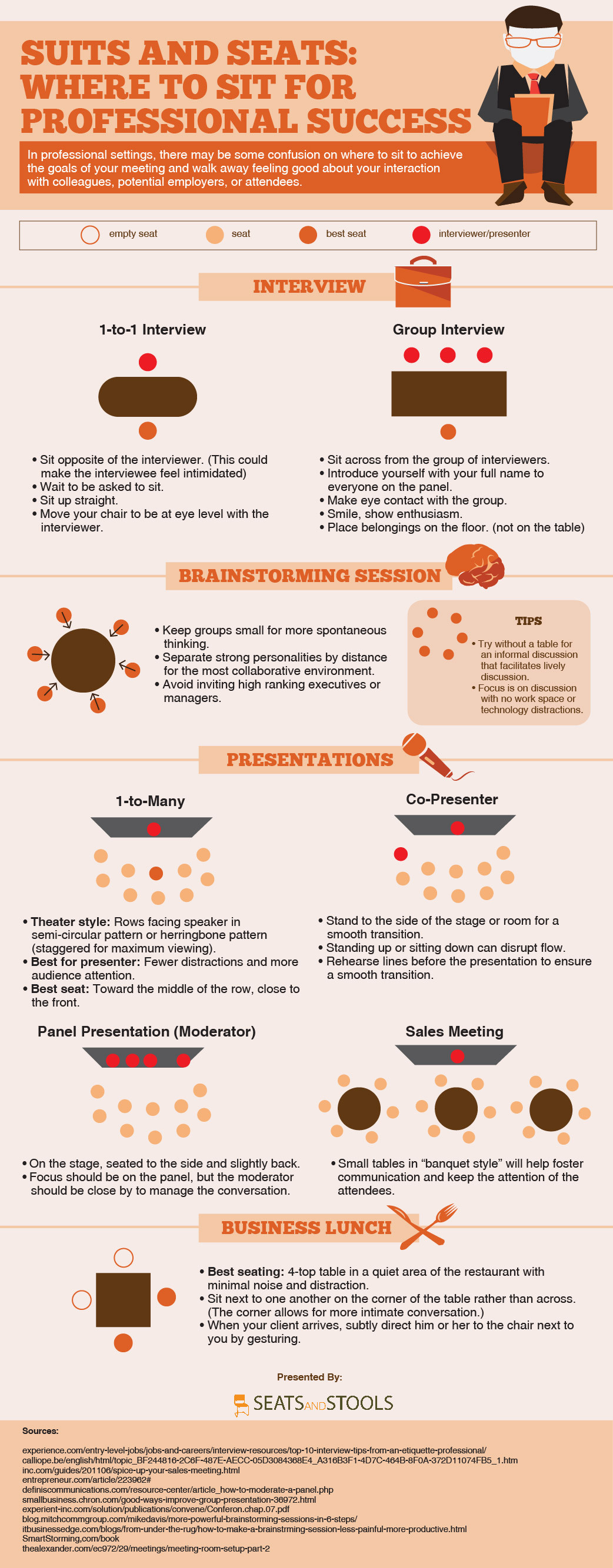In the business world, sometimes even seemingly unimportant tasks and arrangements can have a major impact on how things go for your company, employees and client relations. This situation applies, in particular, to the details of how you arrange the seating in different kinds of business meetings.
The bottom line is that you’d be amazed just how much difference your seating arrangements can have if they’re arranged in one way vs. another. A seating plan that has been set up one way can create a bad atmosphere where little productive communication happens, but a well well planned arrangement can do the exact opposite and foster easy conversation or brainstorming.
Luckily, the people at Seats & Stools have created this handy infographic. It covers some of the researched details of how to best position employees, clients and other business participants for optimal effectiveness in any kind of business meeting.
Here’s a summary:
Doing Interviews the Right Way
One on One Interviews for Maximal Effect
In one-on-one interviews, your best possible seating arrangement for easy communication is one in which both parties are facing each other across a table. This table should not be too wide and shouldn’t put one person in such a position that would make them feel superior to another. This will allow both to communicate easily. In this situation, the interviewer should offer the visitor a seat first, and should sit straight without leaning imposingly forward. But most importantly, they should stay at the same eye level with their interviewee for the sake of creating a sense of equal footing.
Group Interviews Done the Right Way
When it comes to group situations, you’ll be dealing with several interviewers and one interviewee. For these cases, the same rules from above about eye level and a narrow table apply, but with a few additions. All of the interviewers should introduce themselves to the interviewee, and vice versa, while maintaining eye contact. The interviewee should be ready to smile and maintain regular, confident eye contact (likewise for the interviewers). Finally, all personal belongings or clutter should be left on the floor to avoid distractions.
Brainstorming Sessions
As for brainstorming sessions between several employees or partners/clients, informality and openness are the keywords. Here, the best possible layout is one of small groups closely working together on an equal footing where sharing is encouraged. In brainstorming sessions, strong personalities with divergent opinions should not be allowed to dominate the discussion. Executive level employees should be kept out of the meeting where possible so they do not discourage open discussion.
Some further tips:
– Don’t use tables for an even more informal setting.
– Keep the meeting space casual and work-like, without pomp or executive flash.
– Ask everyone to power down their phones, tablets and any other electronics so they can focus on the brainstorming itself.
Presentations
There are four kinds of likely presentations and different practices apply for each:
1-to-many conference
This conference is done in a theater style with the viewers facing a single speaker while sitting in multiple rows or a semi-circle that allows maximum visibility all around. This set-up is ideal for the presenter because it allows for maximum viewer attention and easy communication with the audience.
Co-Presenter
In this case, all the same seating/presentation arrangements that are the case with a single presenter apply but with the addition of a secondary speaker standing to one side of the stage sharing in the presentation. Both speakers should avoid doing anything that distracts audiences while the other is speaking. They should have coordinated their lines well before-hand for the sake of smooth transitions from one to the other.
Panel Presentation
In the case of panel presentations, there will be a moderator and several speakers before an audience. In these cases, the moderator should keep slightly apart from the other speakers while being involved enough to manage their discussion.
Sales Meetings
When it comes to sales meetings, the best arrangements are for a single speaker at a main platform. Or, possibly, even several speakers taking turns at the same platform before a closely packed semi-circle of small tables arranged around the presenters. This will allow easier communication between the audience and sales presenters.
Dealing with Business Lunches
In the case of business lunch situations, the best possible seating arrangements are the intimate kind that foster easy communication in a small group. Thus, in these cases, a relatively small 4 person table should be used. The seating around it should be arranged for maximal intimacy depending on whether 2 or 3 or 4 people will be attending the lunch. If two people are at the table, they should sit at corners to each other instead of across the table.



